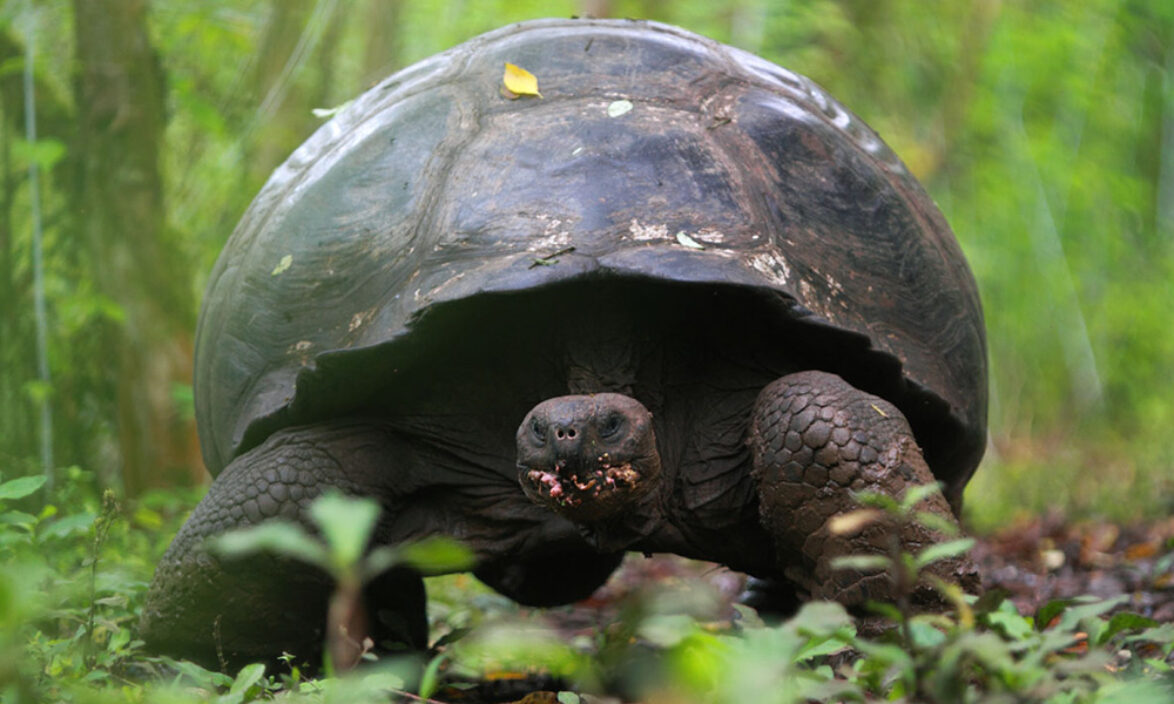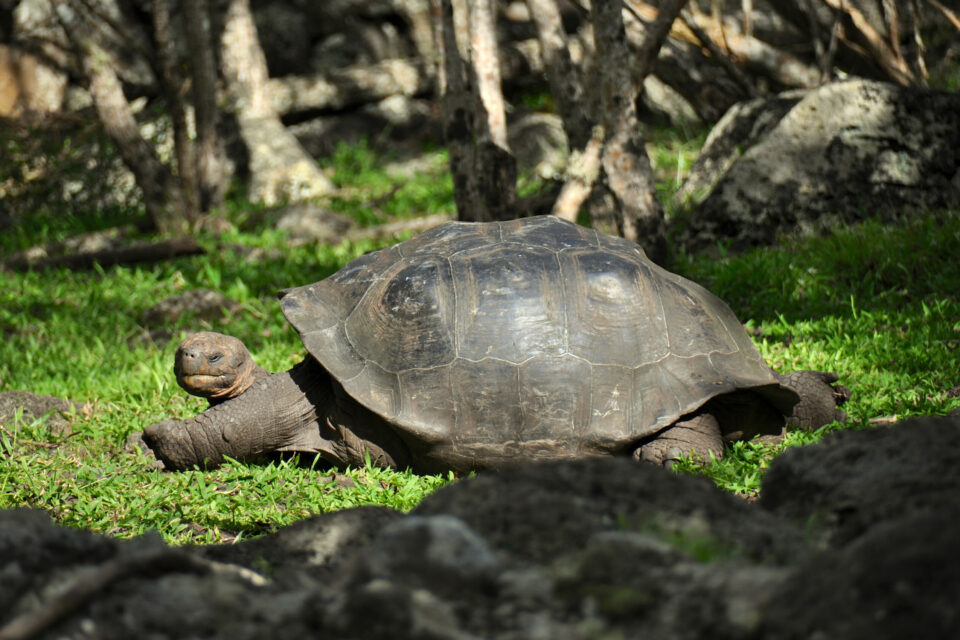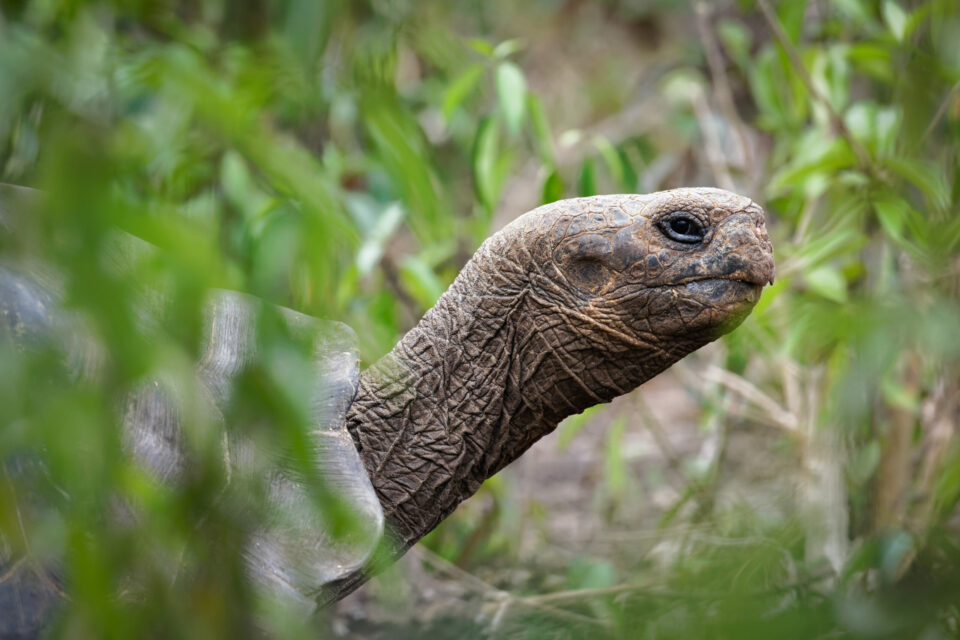

Galapagos giant tortoises and climate change may help invasive plants to spread
One of the greatest threats to the native biodiversity in Galapagos is the ever increasing distribution and number of invasive species.
Unfortunately, new research has just revealed that Galapagos giant tortoises may facilitate the spread of some invasive plant species in the future. This is due to the killer combination of their impressive long distance seed-dispersal services and climate change.
Galapagos giant tortoises are the largest terrestrial reptiles on Earth and can live for more than 150 years, weighing up to 300kg. The tortoises are referred to as ‘Galapagos gardeners’ for several reasons; they are biological bulldozers that carve out paths in the thick vegetation, eating large amounts of plant matter which makes them a major vehicle for seed dispersal. This is essential for many native species! The tortoises are a keystone species in Galapagos, and have created different habitat zones in the Archipelago through their long distance migrations and seed dispersal. Some of the seeds from certain species of plants can only germinate after digestion in tortoises.
However, unsurprisingly, the tortoises cannot tell the difference between native plant species and invasive plant species. A team of top biologists, including Dr Stephen Blake who leads the Galapagos Tortoise Movement Ecology Programme, have been investigating whether Galapagos tortoises are helping to spread invasive plant species across the Islands.

The tortoises are a keystone species in Galapagos, and have created different habitat zones in the Archipelago through their long distance migrations and seed dispersal.
Invasive species are those that thrive outside their native range, causing detrimental damage to the balance of native flora and fauna within local ecosystems. There is now a total of 870 introduced plant species found on Galapagos – outnumbering the native species!
The team of scientists studied the problem of Galapagos giant tortoises dispersing invasive species’ seeds on Santa Cruz island. In the arid lowlands of the island there is a very low abundance of introduced invasive plant species; however the abundance steadily increases as you move into the more humid highlands. The two most common invasive plant species on Santa Cruz island that the scientists investigated were guava and passion fruit. Both these plant species were brought to Galapagos by humans for domestic purposes and are delicious for tortoises.

Guava and passion fruit occur in the humid highlands of Santa Cruz, but their seeds are being dispersed into the lowlands by migrating tortoises. The tortoises transport large quantities of guava and passion fruit seeds into habitats that are currently unsuitable for the germination and survival. The scientists refer to this as ‘wasted’ seed dispersal. The team investigated the seed dispersal of guava and passion fruit in tortoise dung piles and the distribution of adult plants along two elevation gradients of Santa Cruz to assess current levels of ‘wasted’ seed dispersal.
At the moment the wasted seed dispersals are not having any significant negative effects as the seeds cannot germinate in the current conditions of the arid lowlands. However, the scientists were interested to see whether this would be altered with climate change. So they used the results from their studies to create computer models to foresee the consequences of climate change.

870
introduced plant species are now found in Galapagos
It has been predicted that climate change will increase the competitive advantage of most invasive species over natives. The team found that the current levels of ‘wasted’ seed dispersal in lowlands will remain the same for passion fruit but decrease for guava. This means that the guava seeds being dispersed in the lowlands by the tortoises will have a higher chance of germinating and surviving under future climate conditions. This is because the future climate conditions are predicted to be more humid, due to increased hot season temperature and rainfall – making the currently arid lowlands a much more suitable habitat for guava plants. Therefore, the tortoises will be facilitating rapid range expansion of guava on Santa Cruz island. This is assuming that tortoise migratory behaviour continues in the same way.
Eradication of guava seems to be unattainable under existing management constraints and it will become more problematic in the future as the combination of climate change and long distance dispersal by tortoises will cause a rapid increase in the geographical range of guava on the island.

It’s all sounding rather gloomy at the moment. However, the work being done by the Galapagos Tortoise Movement Ecology Programme, partly funded by GCT, is trying to improve our understanding of the ecology of these great reptiles in order to inform future conservation strategies, to try to prevent further spread of invasive plant species. Through tracking the tortoises they can also highlight the areas of lowland on Santa Cruz that may become vulnerable to the spread of guava in the future and need more management.

Plant species dispersed by Galapagos tortoises surf the wave of habitat suitability under anthropogenic climate change
PLOS ONE – July 2017
Diego Ellis-Soto, Stephen Blake, Alaaeldin Soultan, Anne Guézou, Fredy Cabrera, Stefan Lötters
How you can help
By adopting a Galapagos giant tortoise, you can help protect these extraordinary creatures for many tortoise-lifetimes to come.
Related articles


The return of the Floreana giant tortoise

Galapagos giant tortoises: An update from the field

